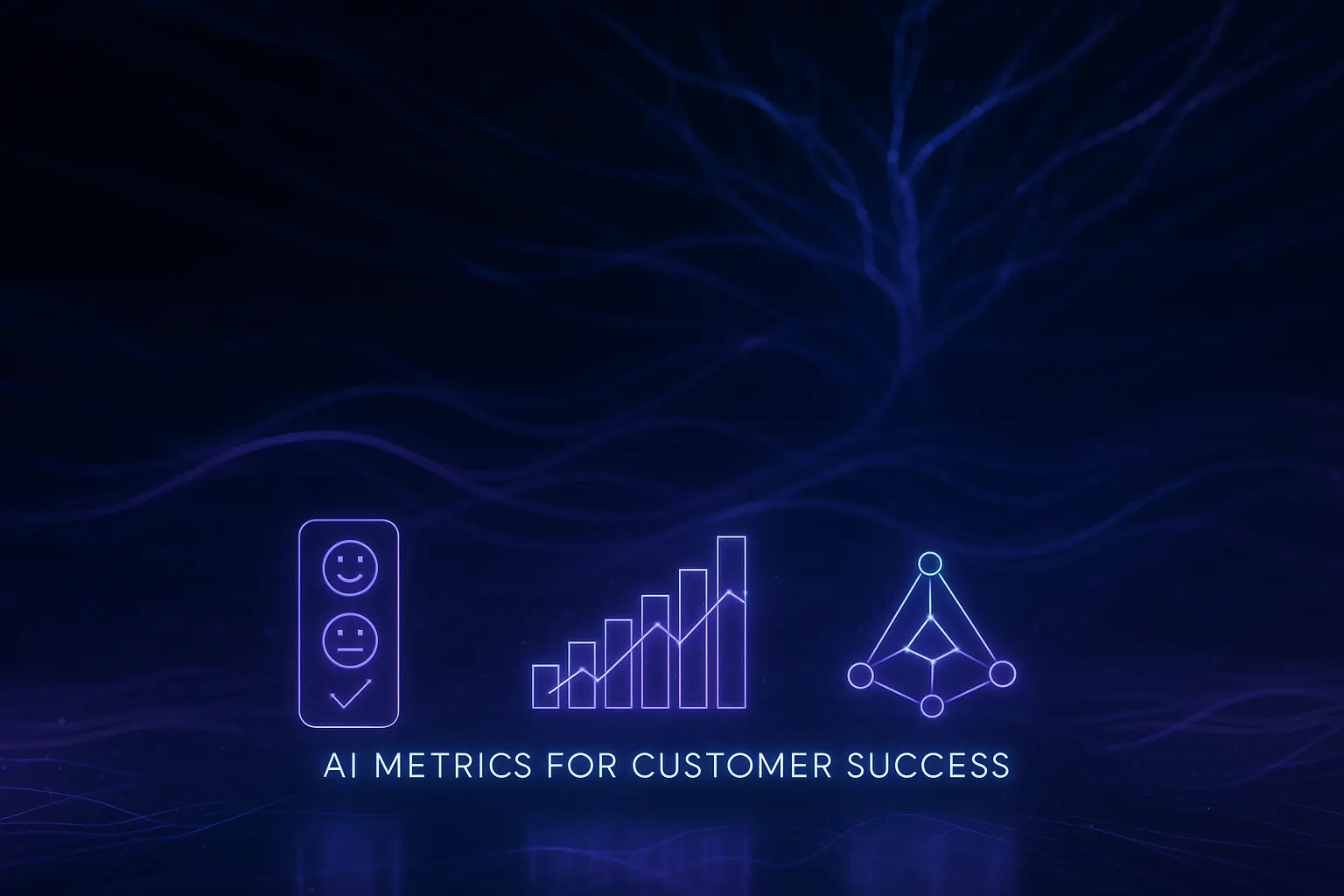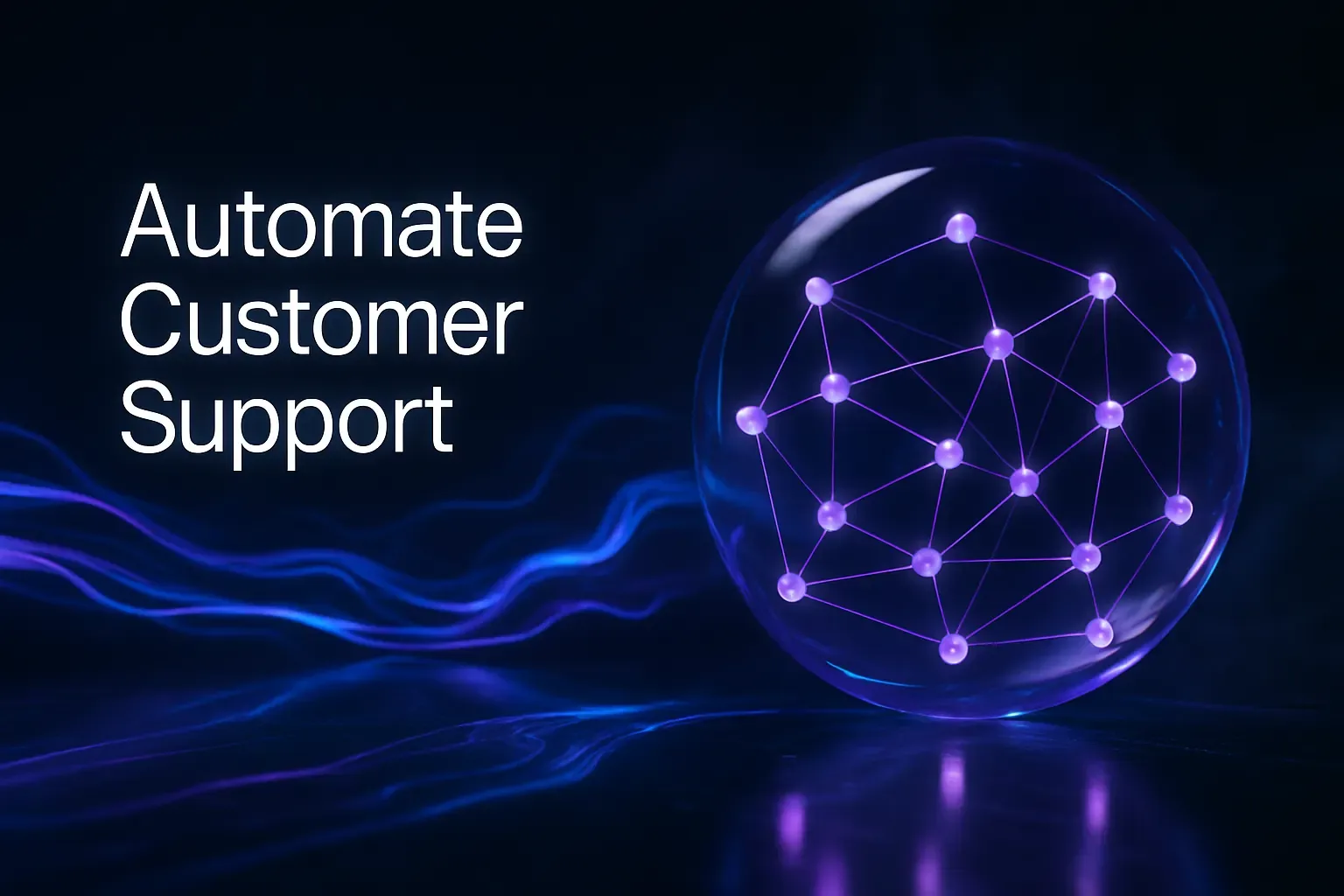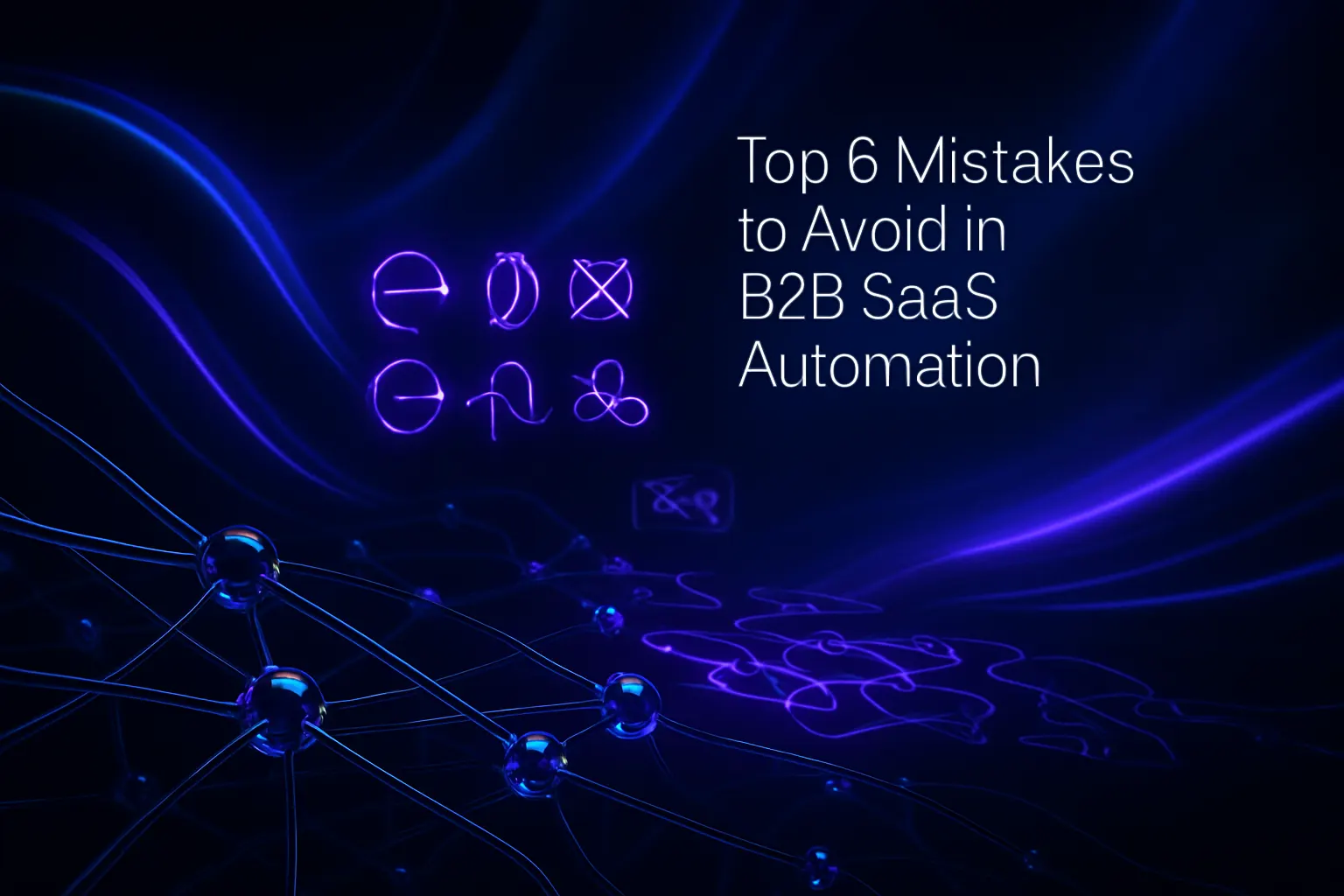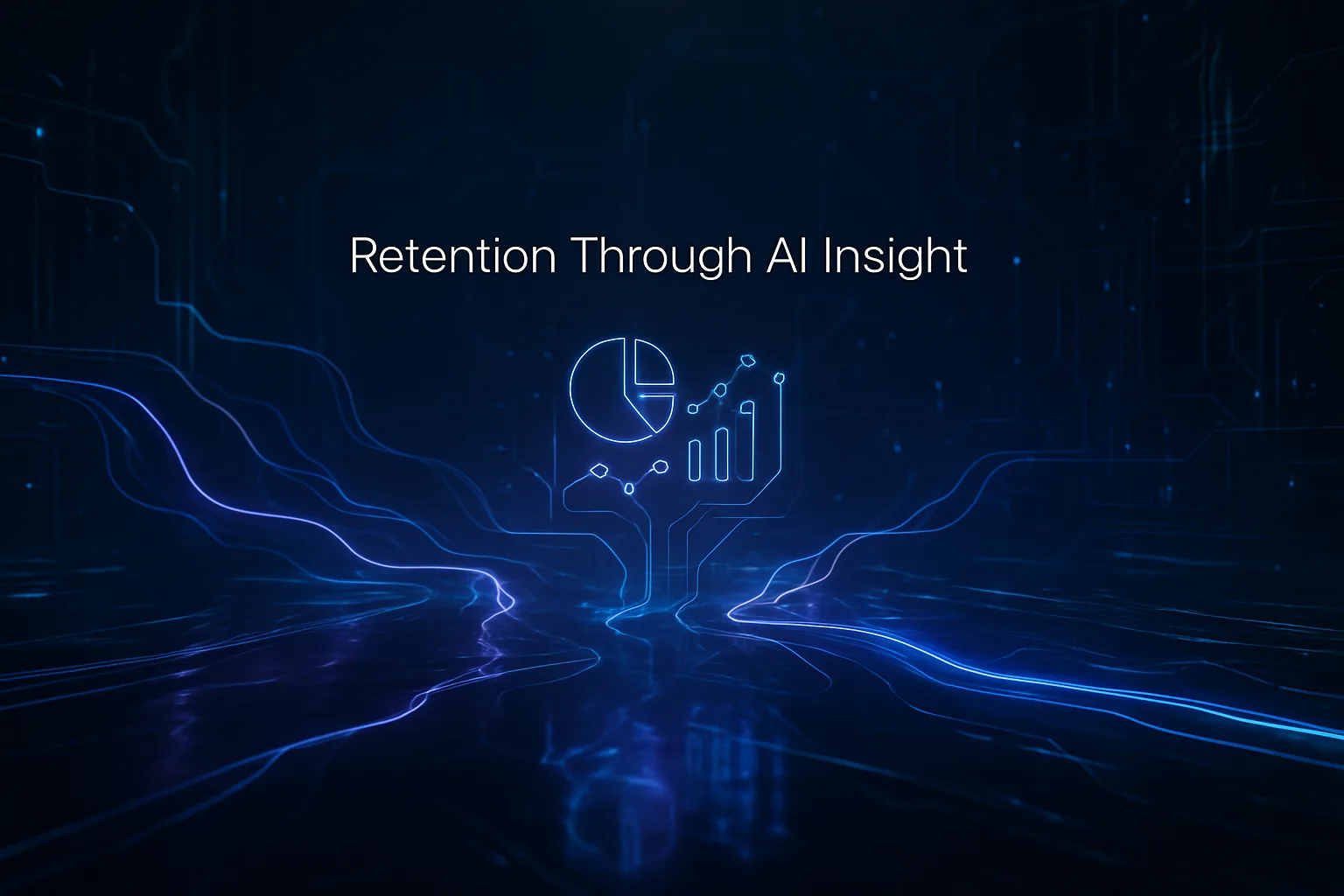Your AI is talking. Are you listening?
AI-driven customer success teams generate a constant stream of signals. Every automated message, suggestion, and handoff contains valuable information. By tracking the right metrics, you transform these signals into actionable outcomes, lower churn, more successful renewals, and faster team learning.
This guide highlights ten essential metrics that illustrate how your AI and workflows perform. You'll learn how to calculate each one, what it reveals, and how to use these insights together to drive real results. Focus on what impacts customer outcomes, not just vanity graphs.
The 10 metrics that matter now
- First Response Time (FRT)
What it shows: Speed to the first reply, whether from a human or AI.
Formula: Time from ticket creation to first response.
Use it to: Spot queue issues and identify routing gaps. Segment by channel and customer priority. - Average Handle Time (AHT)
What it shows: The average effort required per conversation, including reading, drafting, and logging.
Formula: Total handling time divided by the number of resolved conversations.
Use it to: Assess the value of AI-generated drafts. Review alongside CSAT to avoid sacrificing quality for speed. - Time to Resolution (TTR)
What it shows: The total time until an issue is fully resolved.
Formula: Resolution time minus creation time for closed cases.
Use it to: Measure the customer's actual wait time, not just the speed of the initial reply. - First Contact Resolution (FCR)
What it shows: Percentage of issues fully resolved in a single interaction, whether by a human agent or AI.
Formula: Number of cases resolved in one touch divided by total conversations.
Use it to: Gauge answer clarity and policy effectiveness. Particularly useful for chat and email channels. - Customer Satisfaction (CSAT)
What it shows: Customer reactions immediately following a support experience.
Collection: Post-interaction survey using a simple rating scale and optional open feedback.
Use it to: Link support tone, answer clarity, and policy choices directly to customer outcomes. - Customer Effort Score (CES)
What it shows: How easy customers find it to get help from your team or AI.
Collection: Ask how easy it was to resolve the issue right after closing the conversation.
Use it to: Identify friction in workflows, authentication, or during article navigation. - Containment Rate
What it shows: Measures how many customer issues were fully resolved by AI without the need for human intervention.
Formula: Cases resolved by AI divided by cases started with AI self-serve.
Use it to: Assess the quality of self-serve articles, intent mapping, and handoff logic. - AI Suggestion Acceptance Rate
What it shows: How often agents use AI-generated suggestions or drafts.
Formula: Accepted suggestions divided by total suggestions shown.
Add: Edit distance (the amount of changes made to the AI’s suggestion before sending) to evaluate the level of required rewriting.
Use it to: Optimize prompts, style rules, and the completeness of your knowledge base. - Intent Accuracy and Coverage
What it shows: Quality of your AI’s intent classification and how broadly it covers common customer issues.
Formula: Correctly classified intents divided by labeled intents; coverage as supported intents over all encountered intents.
Use it to: Prioritize new automations and improve training data. - Cost per Resolution
What it shows: Support efficiency across all channels and automation tiers.
Formula: Total support costs divided by number of resolved conversations. Segment by queue and channel for deeper insight.
Use it to: Inform decisions on AI investment, content creation, or specialist hiring.
Want more details on proven support metrics? See our practical guide to First Response Time (FRT), Average Handle Time (AHT), and Customer Satisfaction (CSAT) KPIs for essential benchmarks and formulas.
Turn numbers into decisions
Metrics only matter when they drive action. Assign each metric to a single weekly decision, document both the rule and the owner responsible for outcomes.
- If FRT rises for VIPs, reassign a trained pod to manage that queue.
- If Containment Rate drops for “refund” intents, update policy articles and improve handoff logic.
- If AI Suggestion Acceptance Rate falls on weekends, adjust staff schedules and review suggestion timing.
- If CES decreases after identity checks, streamline verification for returning users or known devices.
Measure what your customers feel. Then measure what your team can control.
How to instrument these metrics in your stack
Events to capture
- Conversation created, first reply sent, resolved, and reopened.
- AI suggestion shown, accepted, edited, or discarded.
- Intent predicted, its confidence score, and final human label.
- Escalation reason and the destination team.
- Survey invitations issued and responses for CSAT and CES.
- Policy checks, results of PII redaction, and compliance flags.
Baseline, then segment
Start by analyzing your overall data for a period of two weeks. Then break down the results by channel, language, customer tier, and issue type. This segmentation helps reveal outliers and avoid misleading conclusions.
Define clear formulas
- Use business hours to calculate FRT and TTR if your service level agreements are affected by staffing.
- Exclude any time spent waiting for customer replies from AHT, but include all internal follow-ups.
- Count a case as contained only when the customer confirms their issue is resolved.
- For edit distance, measure changes based on the final sent message, not the AI’s initial draft.
Pairs and trade offs you must manage
- AHT vs CSAT: Faster conversations aren’t always better. Watch for increased reopens or escalations if handle time drops too much.
- Containment vs Escalation Quality: Don’t maximize containment at the cost of poor customer experience. Fast, transparent handoffs help preserve CSAT.
- Cost per Resolution vs Retention: Lower costs aren’t useful if the result is lost customers. Monitor for churn or reduced renewals after aggressive cost-saving measures.
- Accuracy vs Coverage: Only add new intents when your AI model can handle them reliably. Pilot new flows with guardrails to protect quality.
Tools that help you measure
Most support platforms report on First Response Time (FRT), Average Handle Time (AHT), and Customer Satisfaction (CSAT) right out of the box. Zendesk, Intercom, Freshdesk, and Salesforce Service Cloud all provide robust reporting for these metrics. Typewise works alongside these tools as an AI-driven assistance layer inside chat, email, and CRM workflows. It tracks suggestion acceptance rates, tone, and edit distance, all without disrupting your core systems.
- Zendesk and Intercom: advanced conversation analytics and SLA tracking.
- Typewise: AI writing assistance with privacy-first controls and detailed metrics on the acceptance rate of its suggestions.
- Salesforce Service Cloud: comprehensive dashboards and customizable reporting objects.
- Freshdesk: clear SLA flows and excellent multi-channel support for expanding teams.
If you are selecting tools, this comparison of leading support platforms can help you align features to your needs.
Quality and compliance metrics you should not skip
- Tone consistency score: Regularly review replies for adherence to your style guide. Do this weekly for each queue.
- Policy adherence: Track mandatory phrases or legal disclosures for sensitive situations.
- PII redaction success: Monitor how often personal data fields are correctly identified and removed before messages are sent or logged.
- Error Reports: Document any factual errors made by AI responses and tie each mistake back to its source or underlying prompt to improve accuracy.
These metrics help maintain trust and minimize risk, while also enhancing the quality of your training data over time.
Put these metrics to work
You don’t need a huge tech overhaul to get started; you just need clear metric definitions, consistent tracking of core events, and a weekly habit of review. Choose just two metrics to focus on this quarter, link them to one customer-facing and one team-focused outcome, and build from there.
Need help tracking suggestion acceptance, tone, or edit distance directly in your tools? See how Typewise can fit your workflow and privacy needs. Connect with the Typewise team and share your top two metrics to improve over the next 30 days.
FAQ
What is the importance of tracking First Response Time (FRT) in AI-driven customer support?
Speed isn't just about keeping customers happy—it's about diagnosing workflow blockages. Overlooking delays can result in escalating customer dissatisfaction and inefficiencies you can't afford to ignore.
How does Average Handle Time (AHT) impact customer satisfaction?
Fast handling can compromise quality. Prioritize effectiveness over speed, or risk fostering reopens and escalations due to unresolved issues.
Why should AI Containment Rate not be your sole focus?
Pursuing high containment without ensuring quality can crumble customer trust. Balance self-service efficiency with transparent handoffs to preserve service excellence.
How do you balance between Cost per Resolution and customer retention?
Slashing costs at the expense of customer loyalty is short-sighted. Monitor impact on churn rates to ensure savings don't undermine long-term business success.
Why is AI Intent Accuracy crucial but not sufficient?
A highly accurate AI can still fall short if it doesn't cover all customer needs. Focus on broad and reliable intent handling to prevent alienating users and leaving issues unresolved.
Is improving AI Suggestion Acceptance Rate always beneficial?
Simplifying suggestions doesn't equal better service if it breeds complacency. Challenge automated responses to ensure they enhance rather than hinder support quality.
How do Time to Resolution (TTR) metrics mislead if misinterpreted?
Quick resolution doesn't signify customer satisfaction. Dive into whether the resolution actually addressed customer pain rather than assessing speedy closure.
Why is Customer Effort Score (CES) critical for workflow evaluation?
High-effort experiences deter customers and reveal crippling workflow gaps. Optimizing this can unearth friction points and is often more impactful than simply boosting satisfaction.





